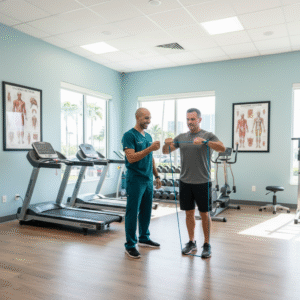Introduction:
Concussions are a common form of traumatic brain injury (TBI) that can have significant effects on an individual’s cognitive and physical function. Neuroplasticity, the brain’s ability to reorganize itself by forming new neural connections, plays a crucial role in concussion recovery. As physical therapists, understanding the principles of neuroplasticity can guide our treatment approaches to optimize recovery and improve outcomes for individuals recovering from a concussion.
What is Neuroplasticity?
Neuroplasticity is the brain’s ability to adapt and change in response to internal and external stimuli. This process involves the reorganization of neural pathways, the formation of new connections between neurons, and the pruning of unused connections. Neuroplasticity is a fundamental mechanism underlying learning, memory, and recovery from brain injuries, including concussions.
Neuroplasticity in Concussion Recovery:
Following a concussion, the brain undergoes a series of changes as it attempts to repair and reorganize itself. Neuroplasticity plays a crucial role in this recovery process by enabling the brain to compensate for the injury and regain lost function. Physical therapists can harness the principles of neuroplasticity to design rehabilitation programs that promote recovery and facilitate the brain’s natural healing processes.
How Physical Therapy Utilizes Neuroplasticity in Concussion Recovery:
Physical therapists employ a variety of techniques to promote neuroplasticity and facilitate recovery in individuals with concussions. These techniques include:
- Vestibular Rehabilitation: Vestibular rehabilitation focuses on retraining the vestibular system, which plays a critical role in balance and spatial orientation. By engaging in exercises that challenge the vestibular system, individuals can promote neuroplasticity and improve balance and coordination.
- Visual Rehabilitation: Visual disturbances are common following a concussion and can significantly impact daily activities. Visual rehabilitation aims to improve visual processing and coordination through specialized exercises and activities, promoting neuroplasticity in the visual cortex.
- Balance Training: Balance deficits are common in individuals recovering from concussions. Balance training exercises challenge the brain to adapt and reorganize, promoting neuroplasticity in the areas of the brain responsible for balance and coordination.
- Cognitive Rehabilitation: Cognitive deficits, such as memory loss and attention difficulties, can occur following a concussion. Cognitive rehabilitation involves exercises and strategies to improve cognitive function and promote neuroplasticity in the areas of the brain responsible for cognition.
- Gradual Return to Activity: Physical therapists work with individuals to gradually reintroduce physical activity and exertion following a concussion. This gradual approach helps prevent re-injury while promoting neuroplasticity and functional recovery.
Conclusion:
Neuroplasticity plays a crucial role in concussion recovery, and physical therapists play a key role in harnessing this natural process to optimize recovery outcomes. By understanding the principles of neuroplasticity and utilizing evidence-based rehabilitation techniques, physical therapists can help individuals recover from concussions and regain lost function.






